Last updated on December 29th, 2023 at 09:55 pm
Both the Rode M5 and the Behringer C-2 are well-known stereo pair microphones mostly designed for small home studios, but they can also be found in some higher-end studios as well, especially the M5´s.
However, there’s a drastic difference in price, with the M5 pair costing roughly 4-5 times more than the Behringer C-2, and this begs the questions if spending that much more is really worth it for you.
So, in this article I will be going over the differences between these microphones, how they sound, their built-in features (if they have any at all), and which one you should go for depending on your needs.
Here’s the short answer of the differences between the Rode M5 and the Behringer C-2: The Rode M5 pair has an overall better sound, with the mids and highs sounding open and airy, and the bottom end sounding full without being muddy. Whereas the C-2’s low end isn’t as present and the higher end sound more “tinny” or “metallic”. However, the C-2’s only cost 1/4th the price of the M5’s.
Now, let’s start by taking a look at the Rode M5 first:
Rode M5
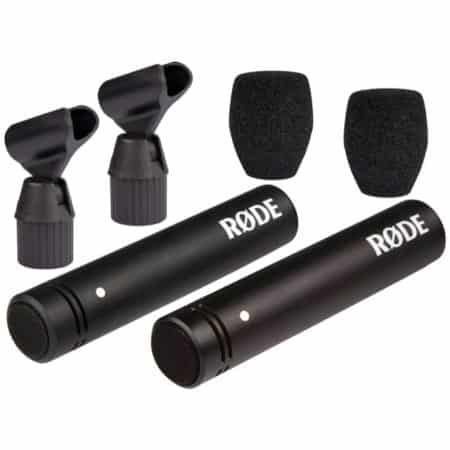
The Rode M5 is a small diaphragm condenser pencil style microphone that features a compact and light design with a sleek and strong black-matte ceramic coating.
Contrary to some other small diaphragm condenser microphones out there, the M5 only sells as a matched pair, and it’s generally priced around $200.
The M5 comes with a WS5 pop filter and a RM5 stand mount, which should help you keep those pesky plosives at bay. However, when recording spoken word or singing, please consider placing a real pop filter in front of it since the included ones aren’t really designed for it.
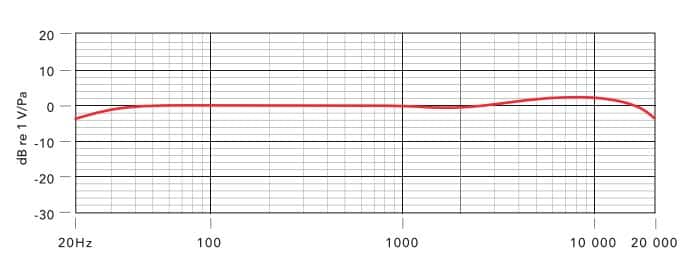
It captures a full frequency response range of 20Hz to 20kHz using a cardioid pickup pattern and it features a small boost in the 7kHz-16kHz range and it slightly pulls back around 20Hz-40Hz and around 18kHz.
The M5 requires +48v of phantom power to work, which luckily, most audio interfaces do provide.
Lastly, the Rode M5 doesn’t come with a PAD or a High-Pass filter, which is actually quite common in small diaphragm condenser microphones in this price range.
How does it sound?
The Rode M5 pair excels in the mid and high frequencies in my opinion, since it doesn’t sound shrill or add any harshness or crispiness to the sound while still sounding open and airy, which is why it works great with guitars, percussion (especially overheads), strings, woodwinds, brass, pianos, and other similar instruments, as well as choirs.
However, one thing to note is that the M5 lacks a bit of presence in the bottom end which might leave the recording sounding a bit too thin.
Of course, this depends on the situation and what the mix requires, since you usually will remove some of that low end regardless when mixing loads of different tracks.
Small diaphragm condensers are known for having a very flat frequency response, which means that they take a pretty accurate snapshot of your sound without adding too much low-, mid-, or high-end.
As far as recording singing/spoken word goes, I have to say that I generally prefer large condensers for this specific job, however, the M5 does capture singing extremely well and you should find out for yourself if recording vocals with it suits your needs.
What comes in the Box?
- 2x Rode M5’s
- Windscreens
- Mic stand mounts
Specifications
| Microphone Type | Small diaphragm condenser |
| Polar Pattern | Cardioid |
| Frequency Response | 20Hz – 20kHz |
| Output Impedance | 200Ω |
| Maximum SPL | 140dBSPL |
| Sensitivity | -34dB |
| Self-Noise | 19dB |
Find out more about the Rode M5 here:
- Rode M5: Amazon, Sweetwater.
Behringer C-2
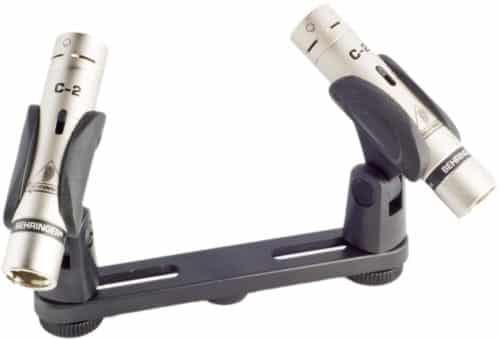
The Behringer C-2 is an entry-level microphone pair that sells for about 1/4th of what the Rode M5’s go for. It features a metal die-cast body that feels pretty sturdy and well put together, although I can see it getting scratched quite easily.
Surprisingly, especially considering the price, is that the C-2’s feature a -10dB PAD and a High-Pass Filter that can be engaged via a small switch on the front of the microphone. Sadly, it’s either or, meaning that there’s only one switch for selecting the HPF or the PAD, both can’t be active at the same time.
Another thing that surprised me is how how well these mics came packaged, since they come in a very sturdy both with a lot of foam in it.
Additionally, you get mic clips for each microphone and windscreens, but just like I mentioned with the M5’s, if you’re going to be recording spoken word/singing, get a real pop-filter and put it in front of them.
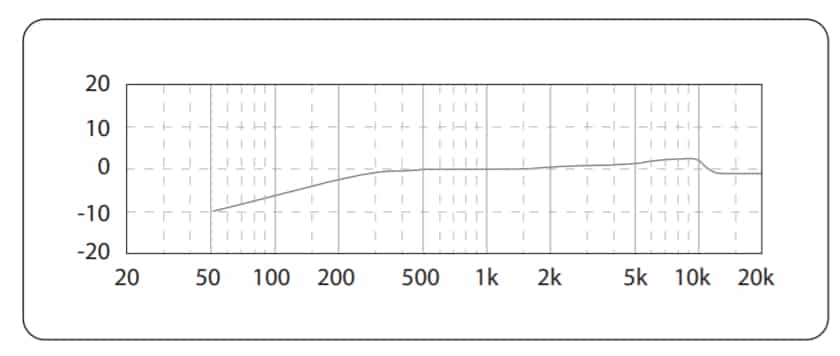
It captures a full frequency response range of 20Hz to 20kHz using a cardioid pickup pattern and it features a small boost in the 5kHz-10kHz range and it slightly pulls back from 10kHz onwards.
However, none of this is really important since what matters most is how this mic pair sounds, so let’s take a quick look at that, shall we?
How does it sound?
Since these microphones are mainly designed to be used on acoustic guitars, piano, choirs, etc., and not so much for recording drums, heavy vocals, guitar cabinets, etc., I decided to try them out on my Guild OM-140 acoustic guitar.
I’m going to put it this way: You get what you pay for.
They don’t sound bad, not at all! Especially considering they extremely low price tag of about $40 for the pair, but they are definitely entry-level:
To my ears they sound a little bit “tinny” and lack a lot of low-end, even without engaging the HPF, which is why I would never consider enabling it.
Even though the highs and mids are very present, mostly because of a lack of low end, it’s not an open or airy sound, just, well… “tinny”.
However, and this is an important point worth considering; When mixing, we generally remove a lot of the low end anyway, which makes these microphones sound sort of “pre-mixed”, if that makes sense? Meaning that you may not even need to remove as much low-end when recording with them and the tracks recorded using the C-2’s will automatically sit better in the mix.
This is why going with the M5’s or the C-2’s really depends on what you’re going to be using these microphones for, since one sounds fuller (better for solo performances), and the other one sounds more “pre-mixed”, simpler -not better- for a full mix scenario.
What comes in the Box?
- 2x Behringer C-2
- Windscreens
- Mic stand mounts
Specifications
| Microphone Type | Small diaphragm condenser |
| Polar Pattern | Cardioid |
| Frequency Response | 20Hz – 20kHz |
| Output Impedance | 75Ω |
| Maximum SPL | 140dBSPL |
| Sensitivity | -41dB |
| Self-Noise | 19dB |
Find out more about the Behringer C-2 here:
- Behringer C-2: Amazon, Sweetwater.
Differences between the Rode M5 and Behringer C-2
The Rode M5’s are a much better pair of microphones all around: They have a richer and fuller sound, the high-end sounds airy without being shrill, and the low-end is absolutely amazing when compared to the C-2’s.
The C-2’s on the other hand, despite not sounding as good as the M5 in any way, literally cost 1/4th of what the M5’s do, and this is something that you have to take into consideration. Plus, as I mentioned earlier, the lack of low-end on these microphones makes it easier for them to sit well in a mix without having to reach for the EQ as much.
My Recommendation
Since I believe that buying quality products usually ends up being cheaper in the long run, since you don’t need to upgrade as often, or even in some cases, I have to recommend the Rode M5’s over the C-2’s.
Not only do they sound a lot better, but literally you will never need to buy another pair of pencil microphones since they won’t need to be replaced (unless you decide to go something extremely high-end, but for most people, that’s not the case).
The only reason to go for the C-2’s, in my opinion at least, is if you need small diaphragm condensers right now and don’t have the budget for something a little better. But you will need to upgrade at some point, which means that it’s going to end up being more expensive in the long run.
You can find both microphones here:
- Rode M5: Amazon, Sweetwater.
- Behringer C-2: Amazon, Sweetwater.
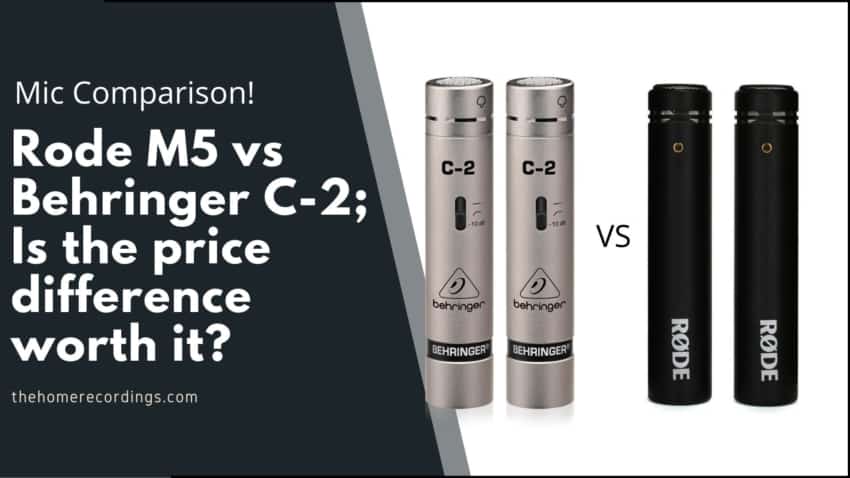
Great review!
Confirming my own thoughts!!